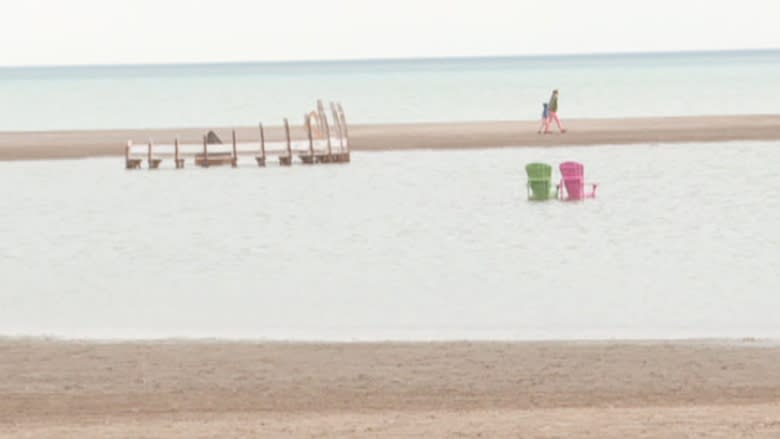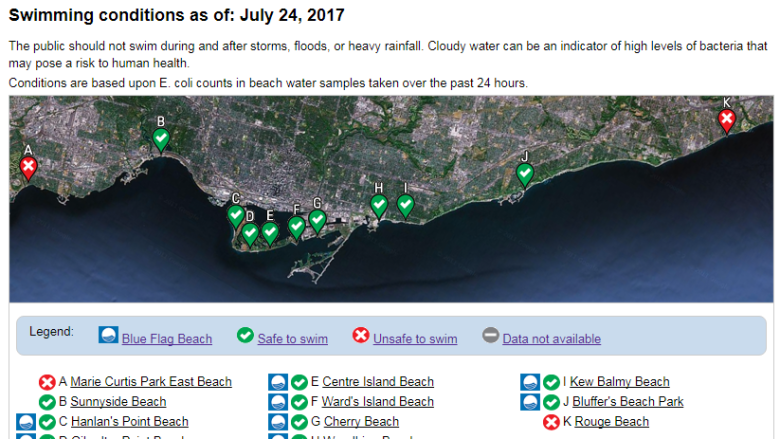Are Toronto's open beaches safe to swim in?
While six of the city's beaches are partially open and supervised, they currently don't meet the safety and accessibility standards for the independent Blue Flag program, which graces the world's most pristine beaches — including, usually, eight beaches in Toronto.
Toronto Public Health says recent water quality tests have shown Lake Ontario contains safe levels of bacteria but undetermined levels of driftwood and other debris leftover from flooding earlier this year meaning the blue flags that normally signal cleanliness are staying down — even as the city says the six beaches are swimmable.
Blue Flag, an international eco-certification for beaches and marinas, was awarded to eight Toronto beaches at the start of 2017. But they have not yet given the go-ahead for the city to fly the flags this summer, saying this year, Toronto's beaches don't meet their stringent safety standards.
"Due to the high water levels, there's been some damage to infrastructure and loss of access points," said Kelsey Scarfone, Toronto's Blue Flag program coordinator.
The Blue Flag program is "one of the premiere programs municipalities strive to achieve," city spokesperson Wynna Brown said. But due to persistently high water levels this year, "we haven't been able to perform our normal level of beach grooming."
For the city, the grooming impediment doesn't appear to be a safety issue.
"Well the water quality is fine, the beaches are swimmable. They're inspected on a regular basis. Every day staff are out there checking on the conditions and we're posting the status of those beaches for the public," Brown said.
Killer driftwood?
Scarfone says that the six open beaches are reasonably safe to swim in — they're just not extra safe, as per the high standards the Blue Flag sets, due to litter and high water levels.
Flooding from earlier in the year has left enough debris that the city agrees it isn't ready for a Blue Flag inspection just yet.
"Our city staff are working as hard as they can to get the island open, to get the beaches groomed and to have the water quality — the ones we have lesser control over because of the weather," Mayor John Tory told reporters on Wednesday.
Scarfone isn't ready to discourage anybody from using the water, so long as bacteria levels stay low.
So far this year, "we've had more days where we've had to post for poor water quality compared to 2016," said Christine Navarro, associate medical officer of health at Toronto Public Health.
That's due to more frequent rain, she said, rather than the flooding. The rain "washes away the fecal matter that's contaminating the beaches," she said.
So...is it safe to swim?
But whether it's safe to swim appears to depend on who you ask — Blue Flag would say the conditions aren't quite safe enough to warrant their internationally-recognized seal of approval, while the city's criteria are satisfied.
"The beaches are safe. We continue to maintain them with the cooperation of Mother Nature in terms of rainfall," Tory said.
"We will have the blue flags flying back there as soon as we can."
Brown reminds would-be beachers to check the Toronto water quality map for bacteria levels, which are updated regularly.
The city's website doesn't mention the current blue flag status, however, and many of the beach sites on the water quality map are accompanied by the official Blue Flag symbol.
Brown did not provide a clear answer as to why the city hasn't mentioned the change of status on their website.
"Perhaps there is some clarity that may be required," Brown said.



